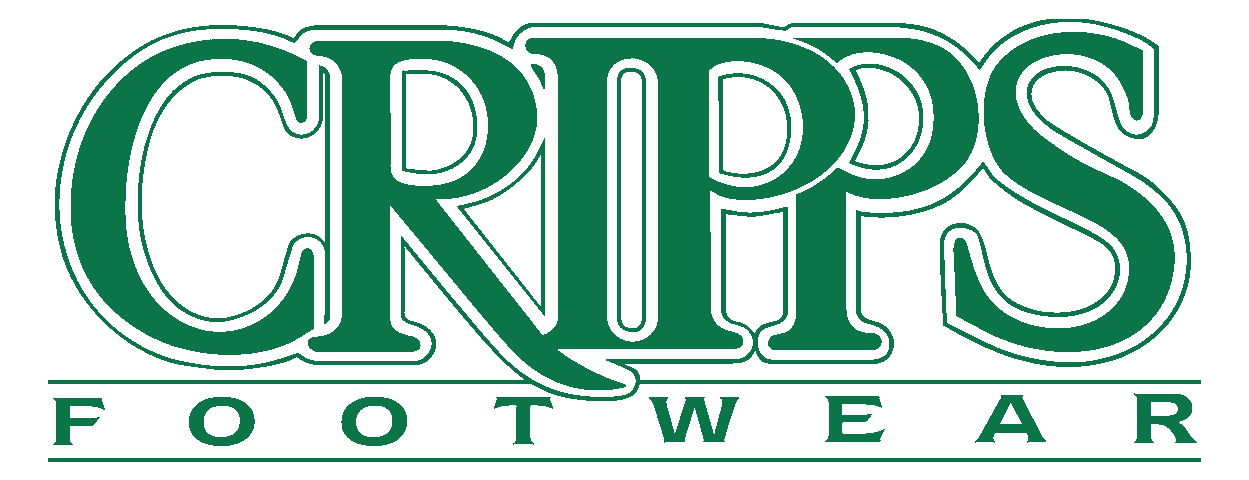Measuring
Print your own Shoe Sizing Guide
Click here to download and print this foot guage on A4 paper
A Word about Shoe Fitting
At Cripps Footwear, we pride ourselves on the service we offer in helping you find the perfect fitting shoe for you and your child.
However, we understand that in this busy day and age, that it is not always possible for you to visit us in person every time, so here is some tips to help you choose the right shoe
1) A fitting gauge is merely a guide. Fitting gauges all vary in calibration – no two gauges will measure the same. Sizes and fittings vary dependent on style, country of origin, manufacturer etc. What it says on the Fitting Gauge may not be the size or fitting you actually require, it is only a starting point.
2) Feet may be “measured” sitting or standing and foot gauges are calibrated accordingly, but the final assessment should be made whilst standing (secondary fit), as the feet spread when standing weight is applied.
3) Buy footwear made of natural materials e.g. leather, cotton etc. as these materials breathe and mould to your foot. Man-made materials e.g. plastic; make feet perspire and return to their original shape – this can cause fungal infections and abrasions. Some shoes have extra features to allow them to allow air circulate while keeping water out e.g. Goretex/Sympatex lining in the shoes.
4) Polish your shoes. They will look better and last longer. Protect nubuck with spray before wearing to keep clean and repel water.
5) Diabetics should take extra special care of their feet and eyes; they can be problem areas. Shoes should always be comfortable and feet kept warm and dry. Make sure shoes and hosiery are secure – but not tight.
6) Wedding, Christening, day at the races? Wear the right shoe for the right occasion! Ladies – think shoes before outfit for your special event – your shoes will stay on far longer than your hat and will be worn a lot more often than your outfit after the event. Comfortable feet will keep you smiling for the photographs – and a gorgeous dress ceases to look gorgeous once you remove your footwear.
7) When does a child need their first pair of shoes? The simple answer is “when the child is walking most of the day and wants to walk outside”. At that time the child needs a pair of shoes to protect his or her feet. This can be between seven months and two years. Never push your child to walk if they are not ready, just because your friend’s
child has been walking for months.
8) Look for shoes that are available in different fittings. The type of shoes you choose for an infant should be designed around the shape of the feet (slim at the heel and wide at the front). Ideally they should also be made in a variety of width fittings, after all there is no standardisation of shoe sizing and feet do not conform to a standard either.
9) Children’s shoes need to be adjustable with a lace/strap/Velcro fastening across the instep, to allow for a finer adjustment without restriction, giving a better overall fit.
10) Never rely on the question “do they feel comfortable?” when fitting very young children. Distortion and cramping can be present without feeling pain and discomfort, and children will often say shoes are comfortable if they like them! If in doubt ask a Supervisor for a second opinion at the time of purchase.
11) Children’s shoes should be professionally checked for correct fit every 4-6 weeks for infants (0-3 years) 6-8 weeks (3-4 years) and 10–12 weeks thereafter. That is not to say your child will need new shoes each time their feet are measured – a qualified shoe fitter will not sell a pair of shoes unless needed, and will be happy to measure and advise accordingly. Children’s feet grow erratically in fits and starts; during this period feet can grow by at least half a size, so it is wise to regularly visit your fitter for advice. Walk out of any shop that asks you the size of your child’s foot and then takes your word for it without checking.
12) Never hand shoes down, they take on the shape of the previous wearer – they will rub and not support in vital areas and can harbour infections.
13) Monitor your child’s sock drawer and discard outgrown or misshapen socks. Buy cotton or wool socks, avoid stretch socks, and check toe seams for a “casting-off” knotthat can rub toes (particularly important if you have diabetes). Socks and baby-grows that are too small at the toes, will restrict growth and circulation.
14) No one style of shoe has been designed or constructed to meet every need. Structured shoes are needed for every day support, plimsolls and trainers for sports and occasional wear, and Wellingtons for wet conditions. The right shoe for the right occasion!
15) Back-to-School time is known as blister season because it is often still warm and active feet get hot and sweaty. When they go back to school in new shoes there is a possibility of rubbing. Only let them wear their shoes with socks on. Let them wear their new shoes indoors at home for short periods prior to wearing all day at school.
16) Saturday’s are the busiest days for shopping, so if you and your child need advice, try to find a quieter time in the week to seek assistance.


